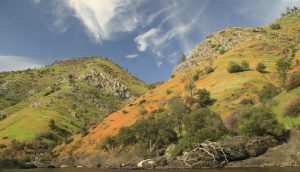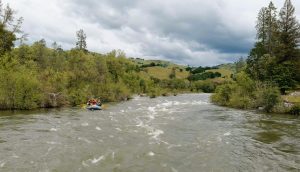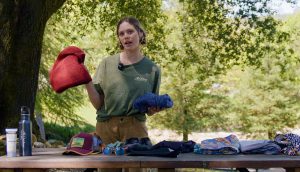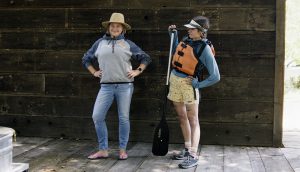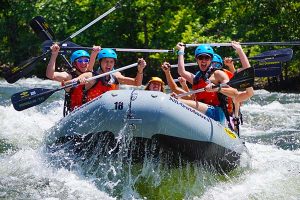What to Wear for Spring Rafting in California – A Visual Guide
Spring is an excellent time to go rafting in California! If you need more convincing about that part, read about Planning a California Spring River Rafting Trip. One key element to enjoying a spring river trip to the fullest is being dressed appropriately. In the video below, senior AO guide, Mathilda, provides some basic tips on what to wear for spring rafting and how to gear up so that you can enjoy your day on the river in maximum comfort.
Stay warm on spring river trips
Let’s start by stating what NOT to wear for spring rafting. The number one rule is to avoid cotton materials. Cotton doesn’t insulate when wet, so although it might seem cozy on the road to put-in, as soon as you hit the first wave you’re done for. Instead, opt for wool, silk, or synthetic fabric like capilene, polypro, or fleece.
Quick Guide to What to Wear on Spring Rafting Trips
- Swimsuit or another moisture-wicking base layer
- Wetsuit and splash jacket (provided by All-Outdoors)
- Quick-drying shorts
- Insulating layer to wear under the splash jacket
- Wool, fleece, or neoprene socks
- Close-toed athletic shoes
- Sunglasses on a strap
Now, let’s break it down in more detail:
Base Layer
The clothing that sits next to your skin should help you retain body heat even when wet. We recommend a bathing suit or another base layer made out of technical fabric that wicks away moisture.
Wetsuit
Spring rafting and wetsuits are a classic combo and for a good reason. One of the benefits of wearing a wetsuit for rafting is that it helps to keep you warm and comfortable. Wetsuits are made out of neoprene which is a material that really only begins to work once it gets wet. When water hits neoprene, it gets absorbed into tiny cells in the fabric which then warm up with your own body heat. As an added service, All-Outdoors provides wetsuits free of charge on our spring trips. These are whitewater specific 1/8“ (3 mm) thick “farmer john” style wetsuits that cover your legs but are sleeveless to provide a free range of motion when paddling. Don’t forget your shorts to wear over the wetsuit to avoid slippage on the raft.
Insulating Layer
Early season rafting conditions often call for another layer to cover your arms with an insulating middle layer. This can be an athletic top or pullover made out of wool, fleece, capilene, or similar athletic fabrics. If it’s really cool, double up!
Splash Jacket
A splash top is another staple of spring rafting and one will be provided to you along with a wetsuit. If it’s windy, your splash jacket will act as a windbreaker. When you burst through huge waves, the splash jacket will decrease the initial cold shock of those waves hitting your body. If you are the proud owner of a dry top (a beefier version of a splash jacket with rubber gaskets at the wrists and neck), you’ll fare even better.
Extremities
Don’t forget about your extremities! Thin wool or neoprene socks are key to keep your feet toasty inside your shoes. Neoprene socks are available for purchase at your trip meet place and some rafters like to wear them even later throughout the season, so it can be a smart investment. A wool or fleece beanie is nice to keep your head warm under your helmet. If you opt for a baseball cap, just make sure it’s not a cotton one. As for keeping your hands comfy, you’d be hard pressed to find a guide wearing gloves for warmth. Guides may wear thin fingerless gloves for sun protection, but beyond that, most full-finger gloves tend to be too bulky and can impair your ability to grasp things, namely your paddle. Most people choose to go bare handed and just suck it up.
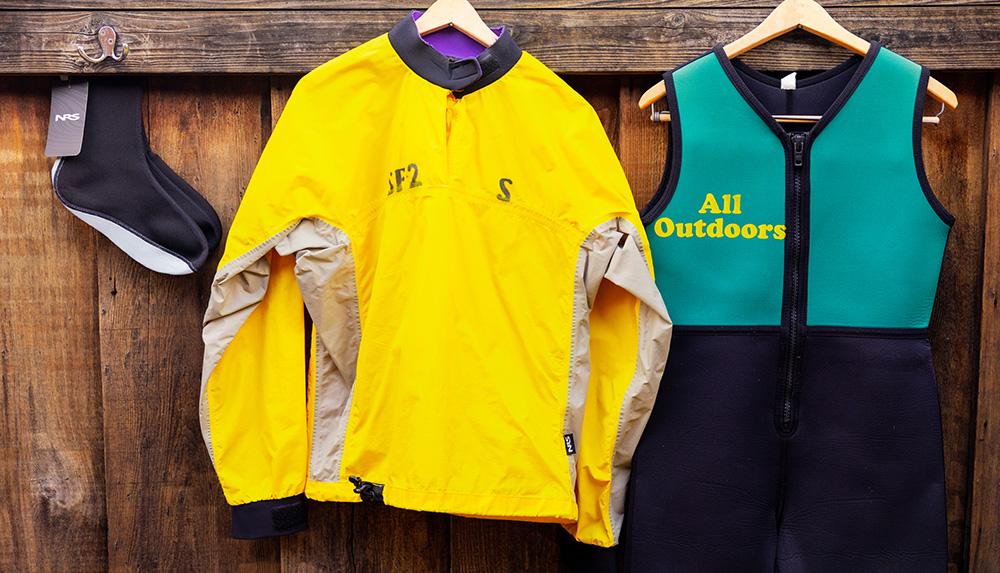
Additional helpful tips
Now that you know what to wear for spring rafting trips, here’s another piece of advice: don’t wear too many layers. A large part of staying warm is a healthy blood circulation (this is why your guide will often make you paddle through calm stretches of river on cold days – it keeps your blood pumping). If you have too many layers on, you run the risk of cutting off your circulation ever so slightly (ever worn three pairs of socks while skiing and your feet still felt icy cold?). Also, too many layers can make it hard for you to move your limbs which could spell trouble if you go for a swim, intentional or not.
Lastly, adequate hydration has a huge effect on your ability to stay warm. Being dehydrated compromises your body’s regulatory system, making it harder for your body to concentrate on temperature stabilization. On the morning of your rafting trip, make sure you drink plenty of water and go easy on the coffee (caffeine dehydrates). Bring along your water bottle and keep sipping throughout the day.
And of course, bring some sunscreen along for your face and hands unless you find the extreme farmer’s tan attractive. You’re ready! Now go plan a day off and get out on the river!
Raft the South Fork American!
This could be you! Paddle through fun, splashy rapids and soak in the river’s beauty. The South Fork American is perfect for first-timers and seasoned rafters alike.
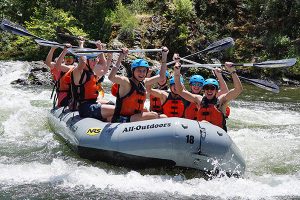
Updated on April 21, 2025
